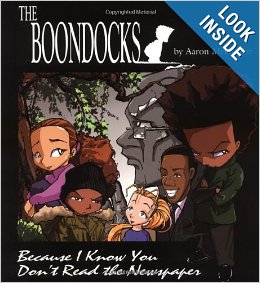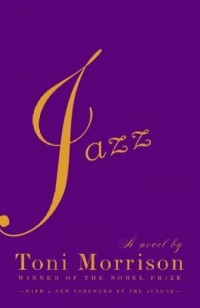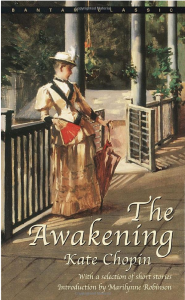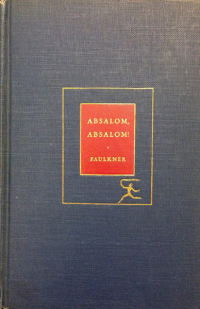Jazmine Dubois

Character: Jazmine Dubois
Source Text: McGruder, Aaron. Boondocks: Because I Know You Don’t Read Yhe Newspaper
Entry Author: David Lwamugira
Aaron McGruder’s highly intelligent and racially charged comic strip, the Boondocks, provides readers some insight into the thinking of a pair of African American youths named, Huey and Riley, who must navigate their way through a mostly white society. The neighbor of these characters , Jazmine, acts a literal bridge between the two worlds because she has a black father and a white mother. During Jazmine’s first interaction with Huey, Huey tells her, much to her despair, that “it’s good to have more black people around.” Jazmine disputes the fact she is black and asks Huey why he would assume what race she was. Huey responds by saying, “Well first of all, Mariah, your afro is bigger than mine.” When she responds with, “I don’t have an afro – my hair is just a little frizzy today,” Huey retorts: “Angela Davis’ hair was ‘a little frizzy.’ you have an afro.” Jazmine then screams in protest, “I DO NOT and who is Angela Davis?” Huey compares Jazmine to Angela Davis, an African American political activist who took part in the Civil Rights movement and she fails to catch the reference. This shows that Jazmine has the physical appearance of an African American but does not fully identify herself as a member of the community, as well as the gap in historical knowledge between Huey, an African American, and Jazmine, a member of both the White and African American communities.
Jazmine’s identity is constantly being determined by others. When asked by a school questionnaire what race or ethnicity Jazmine belongs to, Jazmine leaves the field blank. The elementary school principal calls Jazmine’s mother in order to get a straight answer and she says it’s up to Jazmine to construct her own identity: “We don’t want anyone doing that for her. Is that clear? If she must be called anything, use the term ‘multiracial.’ Never ‘white,’ never ‘black.’ Ok?” Immediately after this speech, the principal decides to ignore her mother’s advice and identify Jazmine as an African American. So many people in this world ignore the fact Jazmine is a mixture of races. By defining her as one or the other, they limit her growth as a person.
In a moment of desperation, Jazmine expresses her feelings in a very open and honest manner that captures the experience of being biracial:Most people don’t understand what its like being different. Like…I once saw a yellow flower right in the middle of a bunch of red roses…everything around it was either green or red, and here was this yellow flower. It looked lonely. That’s what it’s like being biracial. I’m different from everyone else. My mom and dad say that makes me special, but i just think it’s lonely. (McGruder 27)
Her soliloquy shows the reader she is just a young girl trying to find acceptance in a world where defining someone’s race can still mean defining their character. Jazmine wants to live her life free of judgment or the pressure to choose which race she shall identify with. Yet the notion of belonging to one race or another matters much more to her peers than it does to her. Like any human being, Jazmine wants to be treated with decency and respect.
Armand Aubigny
Source Text: Chopin, Kate. The Awakening: With a Selection of Short Stories. 1899. Reprint. New York City: Bantam Dell, 1981. 177-182. Print.
Entry Author: Emma Baker
In Kate Chopin’s short story, “Desiree’s Baby,” Armand Aubigny is the father of the titular child and the husband of Desiree. Belonging to a well-known, respectable Creole family, he owns a plantation called L’Abri that he inherited from his father. He spent his childhood in Paris until his mother’s death, and returned home to the United States with his father. Presumably, he lived with his mother when she was still alive. His role in the short story focuses on falling in love with Desiree, the adopted daughter of the Valmondés, another well-known creole family. Although Desiree comes from an ‘obscure origin,’ as the Valmondés found her around the ‘toddling age’ near the gateway to their home, Armand initially finds that no obstacle to marriage instead asserting, “What did it matter about a name when he could give her one of the oldest and proudest in Louisiana?” However, while his father treated the slaves under his ownership with kindness, “Young Aubigny’s rule was a strict one, too, and under it his negroes had forgotten how to be gay.” (Chopin, 177)
As such, Chopin positions Armand Aubigny as the character with the most power in his societal context. He is male, wealthy, and at the start of the story, both the reader and the surrounding characters believe he is white. One can see evidence of his exercise of this power in the treatment of his slaves as well as evidence of prejudice and racism. He seems reasonable in his acceptance of a nameless wife whose origins are unknown at the start of the novel, but after the birth of their child one perceives changes in his behavior. Others notice the child’s skin tone before he does but he begins to absent “himself from home; and when there, avoided [Desiree’s] presence and that of her child, without excuse.” (Chopin, 179) After Desiree herself realizes the similarity to one of the quadroon boys of La Blanche, a mulatto slave, she pleads with Armand to tell her what it means. He only responds, “it means…that the child is not white; it means that you are not white.” (Chopin, 180) Armand is not suspected to be the reason for the child’s quadroon appearance, as Desiree’s origin is unknown. As she attempts to defend herself by naming her features, he cruelly responds, “As white as La Blanche,” (Chopin, 180) demonstrating that the physical appearance of whiteness holds no power when one carries ‘black blood.’ Following this, he draws further away from his wife, begins to treat his slaves with a greater cruelty than before and does not prevent his wife from walking unprotected into the bayou with her child never to return. His position in a place of power demonstrates how influential his actions and decisions are on the lives of others around him, as well as highlight the discrepancy between an unknown origin or namelessness and the possibility of having black ancestry.
Chopin does not reveal his parentage until the last lines of the story. As he burns all of Desiree’s belongings he finds a letter sent from his mother to his father saying, “I thank the good God for having so arranged our lives that our dear Armand will never know that his mother, who adores him, belongs to the race that is cursed with the brand of slavery.” (Chopin, 182) The reader then retroactively remembers various mentions throughout the story of “Armand’s dark, handsome face,” (Chopin, 179) and when Desiree pleads, “look at my hand; whiter than yours, Armand.” (Chopin, 180) As such, Chopin constructs Armand as a mixed race character who passes for white and maintains, if not enforces, the status quo in order to demonstrate the hypocrisy of the Louisiana culture. In the revelation of his mixed race as the final and pivotal plot-point, Chopin upsets the status quo by suggesting a complete lack of adherence throughout the piece, as well as emphasizing the dire consequences that resulted from adherence to those conventions.
Golden Gray
 Character: Golden GraySource Text: Morrison, Toni. Jazz. New York: Vintage International, 2004.
Character: Golden GraySource Text: Morrison, Toni. Jazz. New York: Vintage International, 2004.
Entry Author: Shalyn Hopley
Golden Gray is the son of white Vera Louise Gray and black Henry LesTroy. Jazz is not really a story featuring Golden Gray, yet his presence in the story is potent. Golden Gray is the product of an illicit relationship between the daughter of a wealthy Colonel from Vesper County, Vera Louise, and “a Negro boy out from Vienna” (140). Golden Gray is conceived during one her rides with the boy out to the woods, and when Vera Louise tells her parents she is pregnant, wordlessly her family gives her money to “die, or live if you like, elsewhere”, disowning her and her child. Vera and one of the novel’s main character’s (Violet’s) grandmother, True Belle, a slave woman belonging to her family, go to Baltimore and raise the child.Golden Gray is an enigmatic presence in the novel, his real personality and significance hard to determine as he is described over and over by different characters, at times the narrator even restarting her tale of Golden Gray to rewrite what she has already written of him. Golden Gray is named Gray for his mother and the color of his eyes, and golden for his skin tone (139). He is raised as an adopted white child, rather than the son of a black slave and Vera, by Vera and True Belle and is said to be the “light of both their lives” (139). When Golden Gray is told the story of his mixed race heritage, he leaves home to meet and confront his father, Henry LesTroy. Yet on his way there, he happens upon a dark-skinned pregnant woman in the woods who he startles, her attempt to flee ending in her injury. He brings the unconscious woman to the house of his father, where she births the child she is carrying. When his father returns home, he helps Golden with the woman and quickly disarms Golden’s potentially murderous intentions, asking Golden Gray what he expected when he came to find his father (172). Instead, Golden Gray runs away with “Wild”, the woman. Wild is implied to be the mother of Joe Trace, Violet’s husband. Henry LesTroy becomes a father figure for Joe.
While the general content of Golden’s story remains the same, the narrator begins her tale of his venture to Virginia three times, only being satisfied the final time after berating herself for not seeing his motivations:
What was I thinking of? How could I have imagined him so poorly? Not noticed the hurt that was not linked to the color of his skin, or the blood that beat beneath it. But to some other thing that longed for authenticity, for a right to be in this place, effortlessly without needing to acquire a false face, a laughless grin, a talking posture. I have been careless and stupid and it infuriates me to discover (again) how unreliable I am. (160)
The narrator’s claims to know Golden Gray’s story are erased by this passage. She is unreliable, unable to know the true complexity of even this minor character.
Why is Golden Gray present in Jazz? He is connected to all these characters from the main plot, but his own story can at best be considered a supplement, and at worst a tangent. Yet his story is there, highlighting the complicated interwoven histories of the main characters and highlighting the unknowable nature of humanity and human love.
Charles Bon
Character: Charles Bon
Source Text: Faulkner, William. Absalom, Absalom! 1936. New York: Random House, 1951.
Entry Author: Claire McDonald
Bon’s race is important to Absalom, Absalom! because of his father and brother’s response to it. Despite the fact that both Bon and Henry are Sutpen’s biological sons, Sutpen rejects Bon because he cannot accept the fact that Bon is partially black. Bon’s status as black also means that Sutpen’s dream of becoming a Southern aristocrat cannot be achieved; Bon cannot inherit his father’s plantation because of it, meaning that Sutpen’s goal of creating a legacy cannot be achieved. Bon also signifies the desecration of the Sutpen bloodline’s purity, which Sutpen also cannot abide by. Faulkner is able to use Bon as a way to comment on Southern perceptions of race. Because Bon is considered to be black, he brings shame upon his own father because he is seen as subordinate; the bond between father and son is severed because Sutpen refuses to accept a son who is, by the one-drop rule, black.


